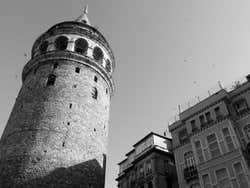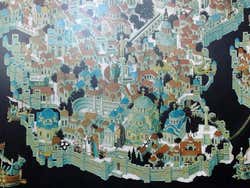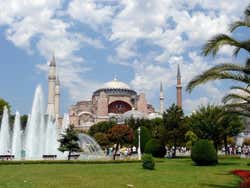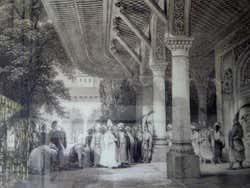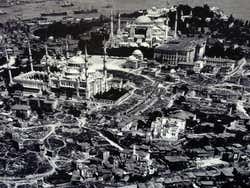
History of Istanbul
Istanbul is the largest city in Turkey and one of the largest in Europe. It's also the administrative capital of the Istanbul province, one of the 81 that Turkey is divided into.
Istanbul is divided into two by the Bosphorus strait, with one half in Asia and the other in Europe.
The long history, and permanent economic activity in the city is due to its location at the crossroads of two civilisations: the Mediterranean civilisations of Rome and Greece, and the Eastern empires coming from Asia.
Up until the year 330 Istanbul was known as Byzantium, and then until 1453 Constantinople. Its current name of Istanbul only came into being on the 28th March 1930.
Istanbul was the capital of the Eastern Roman Empire, and later of the Ottoman Empire. On the 29th October 1923 the Turkish Republic was proclaimed, and the capital of the new country was moved to Ankara.
The vast majority of the city's population is Muslim, with minority populations of Christians and Jews. From a religious point of view, it is also the headquarters of the Ecumenical Patriarch of Constantinople, head of the Orthodox Church.
In 1985 the city was declared a UNESCO World Heritage Site.
Origins: Byzantium
Byzantium was founded on the European bank in the year 667 B.C. by Greek settlers from Megara, who settled in a deep and well-protected gulf known as the Golden Horn.
In the 5th Century B.C. the city was occupied and destroyed by the Persians, to be reconstructed by the Spartan Pausanias in 479 B.C. In 409 B.C. it fell into the hands of the Athenians. Four years later they were conquered again by the Spartans until the Athenian reconquest in 390 B.C.
Byzantium formed a part of Alexander the Great's Macedonian Empire, until the year 279 B.C. when the Celts imposed a tribute, it was relatively independent.
The Roman Empire
In 191 B.C. it was recognised as a free city, although in 100 B.C. it was taken as a possession of the Republic.
In 197 B.C. the emperor Septimus Severus sacked the city and destroyed its walls, but later decided to reconstruct them in the image of other Eastern colonies, doubling the walled area in the process.
The Byzantine Empire
Constantine the Great began to build a new Rome in 324 and in 330 it was consecrated as Constantinople, becoming the capital of the Eastern Roman Empire, known as the Byzantine Empire.
For its inhabitants, it was always a Roman capital. Built upon seven hills, as Rome was, it was divided into fourteen regions ten of which were inside the walls. The first Hagia Sophia cathedral, built by Constantine II next to the Grand Palace and consecrated in the year 360, was severely damaged in 532, which led Justinian to build a new cathedral.
Due to its strategic position between Europe and Asia, Constantinople controlled the route between these two continents and passage between the Mediterranean and the Black Sea. That meant that for centuries it was the major medieval urban centre in Europe, while the Western part of the Roman Empire was engulfed in a profound political, economic and demographic crisis.
The city grew, from 30,000 inhabitants in the time of Septimus Severus to be home to 400,000 during the reign of Justinian.
In the 9th and 10th centuries, with the East-West Schism in the Catholic Church, Constantinople began another renaissance period, and the city continued to be an important cultural and commercial centre in the Mediterranean.
Constantine XI, the last emperor, died defending the city, and it was known as Constantinople until the fall of the Roman Empire in 1453 and in Europe until the 20th century, when the name became known as Istanbul.
The Ottoman Empire
After long years of conflict with the Turks, who had already conquered the rest of the Byzantine empire, Constantinople fell to Mehmed the Conqueror on May 29, 1453, and the Hagia Sophia was transformed into a mosque. This date marked the end of the Middle Ages.
During this period the city underwent a profound cultural transformation, as it changed from a Byzantine imperial city to an Ottoman one, and from Orthodox Christianity to the Islamic religion. Although some churches were converted into mosques, many were conserved and new mosques were built on the outskirts of the city to commemorate the reign of the sultans.
The Turkish Republic
On October 29, 1923, Mustafa Kemal Atatürk established the Turkish Republic, and the capital moved to Ankara.
In 1930 Istanbul officially adopted its current name. And in the 1950s and 60s came a great structural change. Many Greek descendants, belonging to the large Greek community, left for Greece after attacks on the Armenian, Greek, and Jewish communities in 1955.
In the 1960s, at the cost of a number of historic buildings, Istanbul built a modern public transport network.
in 1963 the Ankara Accord was signed, the first step in their process of integration into the European Union.
During the 1970s Istanbul experienced major demographic growth due to emigration from Anatolia, and the offer of work in the many factories built in the outskirts of the city. This created a real estate boom, and many of the outlying towns became absorbed into the city proper.
Today, Istanbul is one of the most visited tourist destinations in Europe, and every year it's visited by more than a million people.
